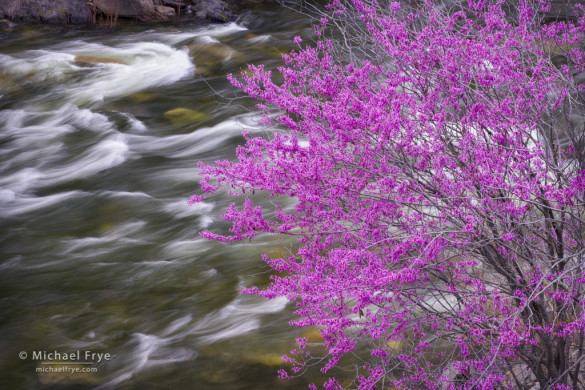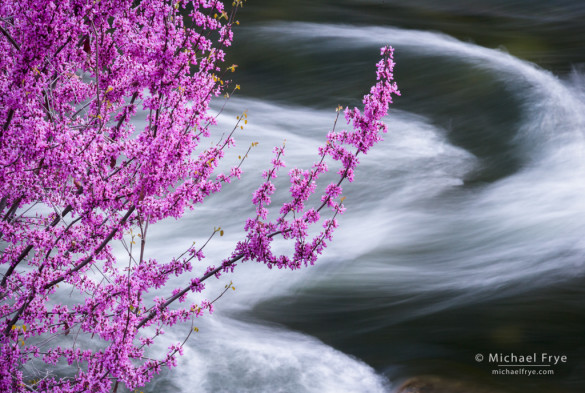Last weekend I visited the Merced River Canyon, looking for flowers. As I wrote last week, there are more blooms than expected, given our dry winter, but it’s still a below-average year for poppies. The redbuds, however, were in great shape last weekend. Some were starting to leaf out, while others weren’t in full bloom yet, so I’d say it was just about peak for redbuds. More will start to leaf out every day, but there should still be many beautiful redbuds this weekend and beyond.
Sunday afternoon it was very windy in the canyon. I found the scene above, with a redbud against the flowing river, and waited for half an hour for the wind to die down before giving up and walking upriver. On my way back to the car it seemed that the wind had calmed a bit, so I set up my tripod again, only to realize that it was almost as windy as before. I waited another half hour, and finally it became perfectly, completely still for about a minute, and I was able to make this photograph.
Later, while exploring another spot, I became interested in another redbud-and-water juxtaposition, with water swirling behind a lone branch. I tried every composition I could think of from every possible angle: wide, tight, vertical, horizontal, lower, higher, left, and right. But I kept coming back to this tight, horizontal framing (below), where a wave created a variety of curving shapes behind the branch.
I recently wrote about the magic of small-scale lighting events – how special light can transform intimate landscapes. But you don’t always need exceptional light to make beautiful photographs. The light just needs to complement the subject.
Soft light – shade or overcast – complements colorful subjects very well. Contrast between sun and shade can overwhelm colors, but soft light provides even lighting which emphasizes colors and color contrasts. It was perfect for the redbuds.
Soft light has another benefit: consistency. The sun is always moving, so the light it casts is constantly changing. This is especially true when things get really interesting; these moments are usually fleeting.
But soft light can last a long time. The amount may vary, but the quality is often consistent for extended periods. This allows you to slow down and concentrate on composition, without worrying about the light changing.
This consistency allowed me to wait for the wind to die down before making the first redbud photograph. Then I was able to try a variety of compositions with the second image, and make many exposures for each composition, trying to capture just the right swirls in the water.
Working with soft light can actually spark your creativity. You’re forced to rely on your eye and your imagination to make a compelling image, and you have time to explore a subject thoroughly. Sometimes ordinary light can lead to extraordinary photographs.
— Michael Frye
Related Posts: Surprising Wildflowers; Light and Mood With Intimate Landscapes
Michael Frye is a professional photographer specializing in landscapes and nature. He is the author and photographer of The Photographer’s Guide to Yosemite, Yosemite Meditations, and Digital Landscape Photography: In the Footsteps of Ansel Adams and the Great Masters, plus the eBooks Light & Land: Landscapes in the Digital Darkroom, and Exposure for Outdoor Photography. He has written numerous magazine articles on the art and technique of photography, and his images have been published in over thirty countries around the world. Michael has lived either in or near Yosemite National Park since 1983, currently residing just outside the park in Mariposa, California.











Toujours a vous encore de belles photos.
Merci Pierre!
The second one is the real stand out for me Michael. The colour pallet works beautifully. Glad you persisted, it paid off in the end with this beautiful image.
BB
Thank you Barbara — glad you like that one!
Another lovely image, Michael. Again, you inspire me to look for the unusual. Most of the time in shots like this I (unimaginatively) try to make the background as unobtrusive as possible, but your “plant and water” style (if I may call it that) adds a whole new dimension that I tend to miss.
Here in the southern hemisphere we are finally saying goodbye to the boring clear blue skies and cruel hard light of summer. I love the winter, with its low-angled sun, and the soft light of overcast days!
Thank you Geoff — glad you like these. Adding a juxtaposition between two different elements can create a richer photo — if you can still keep it simple.
Worth the wait. That’s a beauty.
Thank you John!
Michael, I applied your suggestion re poppies yesterday, photographing a small group of blooms in bright shade before they closed up, against a dark background. I used the long end of my 100-400mm lens for shallow DOF. I was pleased with the result. Thanks for the advice.
Great Sylvia — glad that worked for you!
The swirling water in the second one really works for me. Soft light works well for bird photography as well. Especially so for very brightly colored birds. It also cuts down on annoying shadows.
Thanks Ken! I agree with you — soft light can work well for birds. Frontlight too.